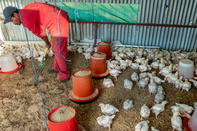While vaccination has become one of the most valuable weapons in the poultry farmer’s armour against certain diseases, it is not a foolproof guarantee that birds will not fall ill.

A specific vaccine, for example, is targeted at a specific strain of a disease, so birds might still become infected if another strain of the disease breaks out. The vaccines may also fail to induce immunology if something went wrong during the application process.
For the best outcome, vaccination should form part of a greater disease prevention strategy that also includes effective biosecurity, sound hygiene and a stress-free production environment.
Producers should work with their veterinarians to tailor a vaccination programme aimed at targeting the biggest disease threats in their production areas. When buying day-old broiler chicks or 18-week old layers, they may also demand a health certificate as proof that the birds have been vaccinated against.
Application Methods
The most common methods used to apply vaccinations on layer and broiler farms, include vaccination through spray, eye-droplets or drinking water. With spray application, the vaccine is diluted in water and sprayed onto the birds.
The sprayers may be extremely sophisticated, with boxes of chicks moving through automated overhead misters on a conveyer belt, or less sophisticated, with people applying the vaccine via a backpack and handheld sprayer.
Finer droplets are generally more effective than having big droplets. The birds should also be sprayed early in the morning before it is too hot and under wind still conditions.
With eye-drop vaccination, one drop of a vaccine, dissolved in water, is applied in one each birds’ eyes. The vaccine should be properly mixed and an accurate dropper is needed to ensure the vaccine is applied correctly.
Eye-drop vaccination is highly effective when done properly, but it might be too labour intensive on some farms as all the birds have to be caught to be vaccinated. It is a good option for farmers who do not have that many birds or in communal production systems where labour might not be that expensive.
Vaccines may also be applied via drinking water. For the best results, the South African Department of Agriculture, advises producers to remove the drinking water for two hours, to ensure the birds are thirsty enough when the vaccine water is given.
In very hot weather, it may not be necessary to hold the water back. It might be necessary to add more drinkers to the production area, to ensure all the birds have enough space to access the vaccine water. Ordinary water should be given afterwards.
Dyes may be used during any of these methods to show whether all the birds have had access to the vaccine or not.
Success
After vaccination, birds should be monitored to see whether immunisation occurred. Birds should develop a mild reaction to the vaccine, two to three days after application.
The reaction may last for five to seven days, and depending on the type of vaccine given, may include symptoms such as respiratory noises or snickering, head shaking, watery eyes or lesions. Blood checks may also be done to see if birds have developed immunity.
Vaccination might have failed if no reaction occurs. A poultry health technician or veterinarian might have to be consulted if the reaction lasts longer or is more severe than what is usually considered normal.
Failure
The South African Poultry Association (SAPA) identifies human error as the main cause of vaccines failures. SAPA gives the following tips for good vaccination outcomes:
Most vaccines have to be kept at temperatures of 4-8°C. So, use a cool box to maintain these temperatures during transport and store the vaccines in a reliable fridge once on the farm. If the vaccines have been delivered, ensure they are still cold when they reach the farm.
The vaccines should be protected from direct sunlight and heat.
Check the expiry date on the vials containing the vaccines.
Mix and apply the vaccine as instructed.
The vaccine should be used as soon as possible after it has been mixed.
Use the correct dosage.
Use the right product, as various strains of different diseases exist.
Apply vaccines at the appropriate time. Certain vaccines do not work on young chicks and booster vaccines need to be given at the right time to enhance immunity. It also does not help to give a vaccine when birds are already ill.
Ensure that people who administer the vaccines are properly trained to do so.
Ensure that all birds receive an equal dosage, instead of some receiving an overload and others being under supplies, especially when the vaccine is administered via spray or drinking water.
If the vaccine is administered via drinking water, ensure the water is chlorine-free because chlorine will destroy the organisms used in the manufacturing of the vaccine.
Do not give antibiotics when administering live vaccines, as the antibiotics might destroy the organisms in the vaccine.
Do not give more than one vaccine at a time, unless the vaccines have been combined by a reputable manufacturer.
Do not vaccinate birds that suffer from some sort of stress, caused by environmental extremes, poor nutrition, parasitism or disease, as these birds will not have enough energy to form antibodies in response to the vaccine. Vaccination could also aggravate the existing stress and lead to secondary infections.
Keep a record of which vaccines were administered when and when the next vaccines should be given.